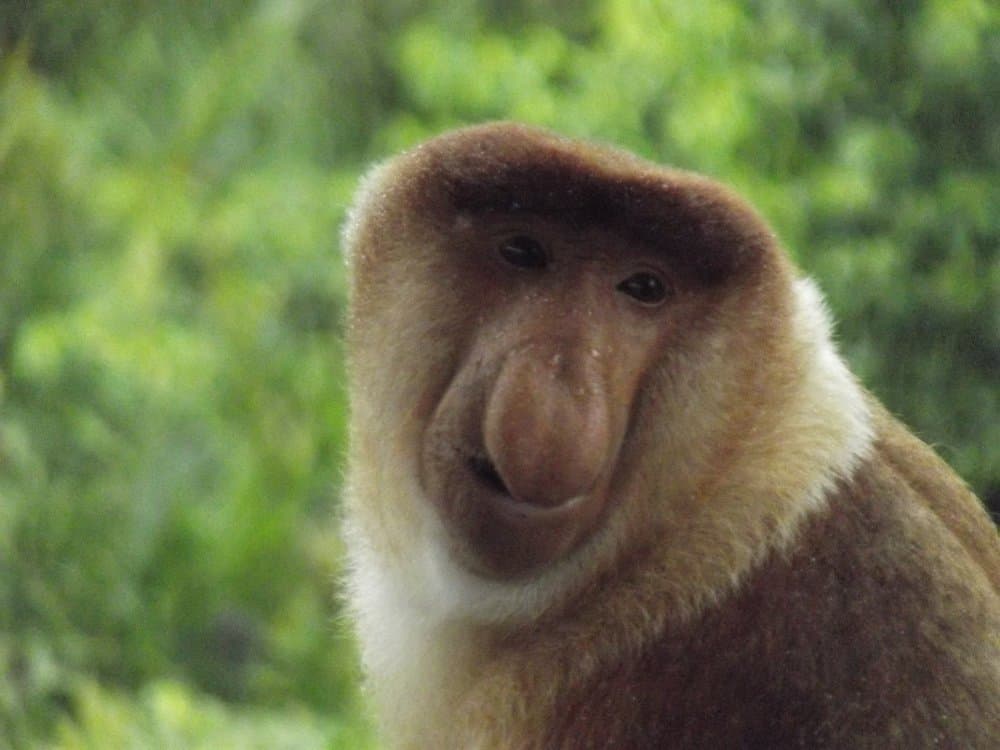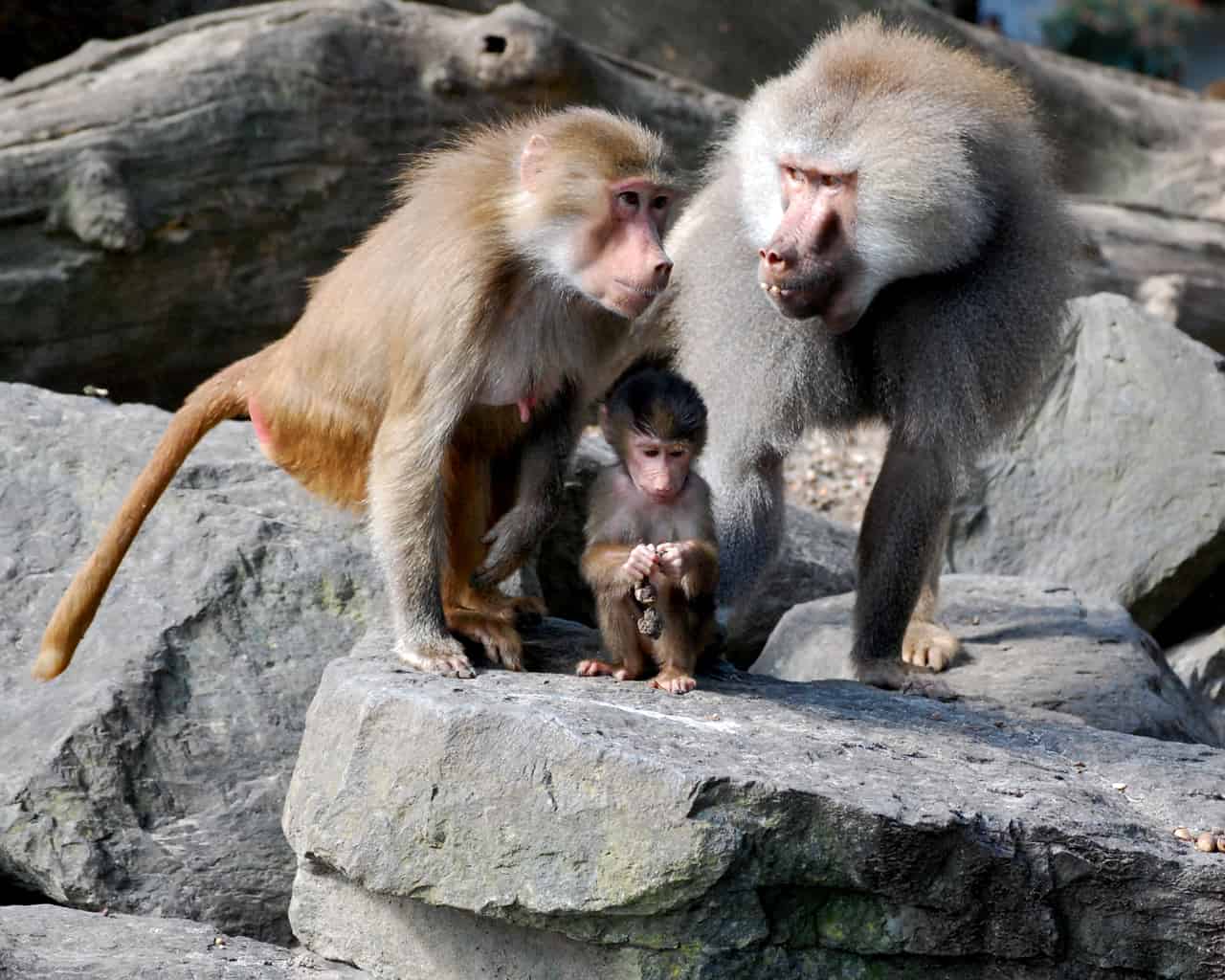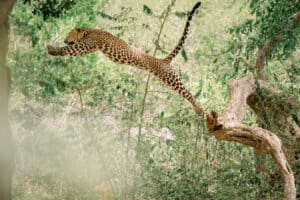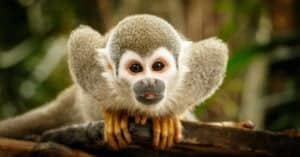Monkeys share a range of common characteristics. Some of these characteristics include their tails, opposable thumbs, and the fact that they are social creatures who need to live in groups. However, there are some attributes that monkeys do not share, such as large noses. Not all monkeys have big noses, but the three monkeys with the biggest noses in the world are the proboscis monkey, baboons, and mandrills.
Proboscis Monkeys Have the Biggest Noses

The proboscis is one of the monkeys with the biggest nose in the world and lives primarily in Borneo.
©Wendy Bird – Copyright A-Z Animals
The proboscis monkey has the most oversized nose of all monkeys and primates. The male proboscis monkey’s nose is huge, growing up to seven inches long. On the other hand, the female of this species has a smaller nose. And even stranger, the larger the male’s nose, the more attractive he is to the female. The proboscis monkey is so well-known for its massive nose that it has another name: the ‘Monyet belanda’ monkey. This name literally means the ‘long-nosed’ monkey.
Appearance and Diet
Proboscis monkeys have fur in different colors, varying from bright orange to yellow or pink. Newborn proboscis monkeys have blue faces that eventually turn to a cream color. These monkeys are herbivorous, so their diets mainly consist of fruits, seeds, young leaves, and mangrove shoots. They also consume caterpillars, larvae, and other invertebrates to get their protein intake.
These are old-world primates and native exclusively to the island of Borneo in southeastern Asia. These monkeys live near the coastal areas in the mangroves and swamp forests. They will also sometimes live along rivers, riparian forests, and rainforests.
Big Nose Proboscis Monkey Behavior
Proboscis monkeys are social animals like most monkeys and live in troops with two to 30 members. These troops typically consist of a single dominant male with the females and all their infants. In some troops, the dominant male can have up to ten females in his harem. Male proboscis monkeys defend the troop members and will protect and show aggression by exposing their teeth and making loud, honking sounds. Females forage for food and care for infants.
Troops of proboscis monkeys are known to live alongside other groups in areas with sufficient food and water sources. The monkeys from different troops sleep and rest together, often in the mangroves along the water’s edge. Because proboscis monkeys live near water, they have become strong swimmers and love spending time in the water.
Baboons: Monkeys with Big Noses or Snouts

Anubis
baboons
are monkeys with big noses or snouts that are endemic to Kenya, Ethiopia, and Mali.
©Dick Mudde, Public domain, via Wikimedia Commons – License
There are five separate species of baboons, and they all have large noses. Baboons are known for their long snouts, with the nostrils at the end of these noses or snouts. Male baboons also have long fang-like canine teeth. These monkeys are primarily terrestrial and live in the dry regions of Africa and Arabia. Baboons climb trees where they keep watch, sleep, and sometimes feed. A baboon’s diet consists of fruit, grass and grass seeds, pods, tubers, and roots. They also eat animals like rodents, birds, and even gazelle fawns. Some baboons will be opportunistic and kill lambs and steal crops.
Five Different Baboon Species
There are five different baboon species, each with large noses or snouts. These species include the following:
- The Chacma is found in southern Africa. These baboons are brown to black.
- The smaller yellow baboon is native to Zambezi, Kenya, and Somalia.
- The Anubis, or olive baboon, is found in Kenya, Ethiopia, and Mali. These baboons are olive in color, and males have a large mane around their heads and shoulders.
- The small red Guinea baboon is common in western Africa. The males have a cape of hair.
- The hamadryas baboon inhabits parts of the semidesert hills along the African and Arabian coasts of the Red Sea. Females are brown, and males are silver in color with an enormous cape of hair on the neck and shoulders.
Baboon Reproduction
Female baboons are known to have a menstrual cycle that lasts for 35 days. After that, males will compete to mate with females, and the most dominant male will mate with females who are estrous. Female baboons are pregnant for five to six months and give birth to one infant. Infant baboons are black, and they are mischievous and playful.
Mandrills: Monkeys with Big and Colorful Noses

Mandrills are monkeys with big noses that include collagen fibers that give them their vibrant color. These monkeys live in the rainforests of equatorial Africa.
©Nikolay 007/Shutterstock.com
Mandrills are mainly ground-dwelling and live in the rainforests of equatorial Africa from the Sanaga River southward to the Congo River. Like baboons, they have long snouts with nostrils at the end. Mandrills also have prominent brow ridges and small, close-set eyes.
Physical Appearance
Besides the big nose of the mandrill, its body shape is stout with a short tail. Male mandrills feature colorful patches of skin on their faces and buttocks. The bright skin patches on their faces are ribbed and showcase colors from blue to violet and scarlet. Their buttocks are mainly pink with blue shades on the sides. Besides these unique markings, their body fur is a dull brown. However, their beards and neck fur are yellow, with black shading around their eyes.
The mandrill is the largest old-world monkey. Adult male mandrills can grow to three feet long and weigh up to 77 pounds. The female mandrills are smaller and weigh up to 29 pounds. In addition, females are duller in color than males as they have bare faces and buttocks. Mandrills have a diet that consists of fruit, roots, insects, and small reptiles and amphibians.
Mandrill Troop Behavior
Similar to proboscis monkeys, mandrill troops consist of one dominant male and a group of female mandrills. In some troops, there can be up to 20 female mandrills. In addition, mandrills will join other groups and travel together. Ultimately, these groups can number up to 100 members or even more.
Up Next – More About Monkeys Than Big Noses
- Do Monkeys Eat Meat?
- Monkeys vs. Apes: The 5 Main Differences
- The 10 Smallest Monkeys in the World
- 10 Incredible Howler Monkey Facts
- Not My Circus, Not My Monkeys: Meaning & Origin Revealed
The photo featured at the top of this post is © David Evison/Shutterstock.com
Sources
- Britannica, Available here: https://www.britannica.com/animal/baboon
- The National Wildlife Federation, Available here: https://www.nwf.org/Magazines/National-Wildlife/2010/Mysterious-Mandrills
- Science Direct, Available here: https://www.sciencedirect.com/topics/agricultural-and-biological-sciences/mandrillus-sphinx
Thank you for reading! Have some feedback for us? Contact the AZ Animals editorial team.






